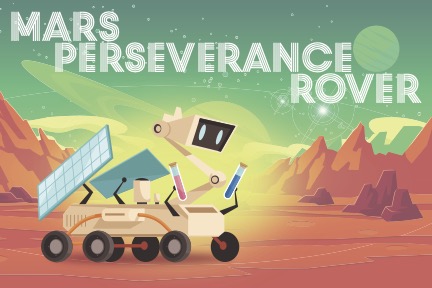UNLV professors Elisabeth Hausrath and Arya Udry continue to break the conventional boundaries of research and geology with their participation in the NASA Mars 2020 Perseverance Rover Mission.
The rover, Percy, successfully collected two new samples that are claimed to showcase evidence of past water and rock interactions on the famous red planet.
Both professors say they are excited to be part of the team that could someday find evidence that life has existed on Mars when the samples come back.
The NASA Mars 2020 Mission Fact Sheet states that the Perseverance rover is designed to better understand the geology of Mars and seek signs of ancient life. The goal of the mission is to collect and store a set of rock and soil samples that could be returned to Earth in the future for further studying. It will also test new technology to benefit future robotic and human exploration of Mars.
Through her contributions on the Mars 2020 Mission, Hausrath specifically has helped select samples to be returned to Earth from Mars with the rest of the science team.
“My favorite part about this opportunity has been contributing to a team effort,” Hausrath said. “Offering input to the science team on what kind of measurements the rover is able to make has been so rewarding and exciting overall.”
After graduating from Brown and Penn State, Hausrath now works as an associate professor at UNLV, teaching a variety of general education classes like physical geography and global warming and upper level classes, such as principles of geochemistry. In addition to mentoring graduate students in her lab, she participates in running the department as a Graduate Admissions Coordinator
“I am also very excited to be working on the Returned Sample Science Board, which is helping provide scientific guidance on aspects of Mars sample return for the Mars 2020 mission,” Hausrath said to NASA.
Alongside Hausrath, Professor Udry serves as a participating scientist in the mission studying igneous rocks, rocks made from lava and compositions of the Jezero crater.
Udry’s research focuses on planetary igneous petrology, including martian petrology. She is particularly interested in understanding martian magmatic processes, using meteorites and surface rock compositions.
Udry’s research also expands to the asteroid belt, with investigation of enstatite-rich meteorites that are comparable to those found on the planet Mercury.
“One of my roles is to actually get images and data derived directly from Mars for a specific instrument, for ‘Super Cam,’ the one that has the laser to study the chemistry of the rocks,” Udry said. “And, that has been so fun sometimes to be one of the first humans on Earth to see new images and new data from this planet.”
Hausrath says the team of more than 100 scientists hopes to learn more as Perseverance continues to take additional core samples as it moves across Jezero Crater where it landed in February. That area of Mars is believed to be an ancient river delta where water deposited soil and debris from a wide swatch of the Martian surface, which is why it was chosen as the landing site.
Since launching on July 30 of 2020 and landing on Feb. 18, the rover is set to spend at least one Mars year (two Earth years) exploring the landing site region, analyzing the area, collecting samples and interpreting the data received.
Future goals for the rover are to continue interpreting measures and samples while also mapping out future excavation sites on the red planet.
NASA is also preparing two more missions that will eventually be needed to bring some of those samples back to Earth. The first of those missions is set for launch in 2026.

